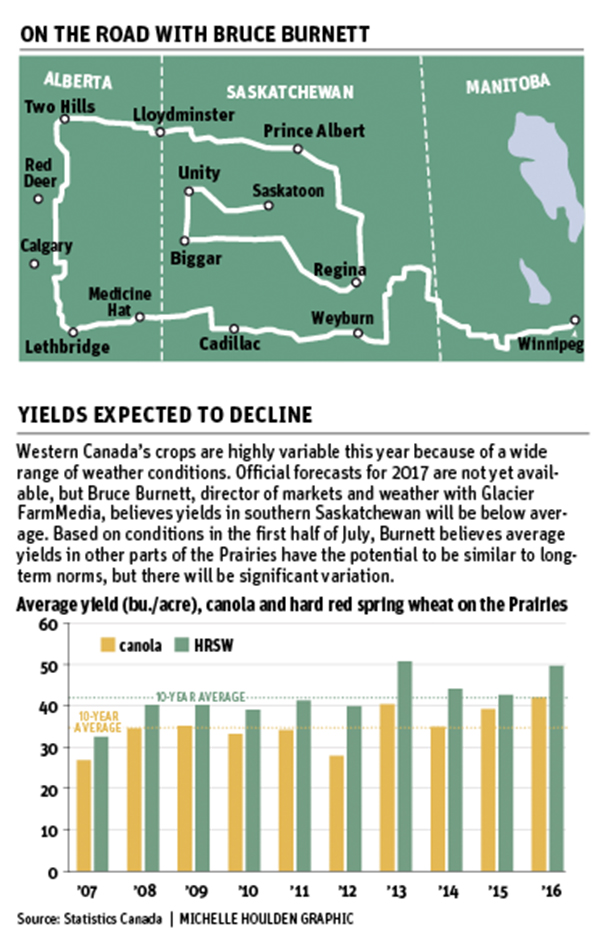After a 4,500 kilometre tour of the Canadian Prairies, Bruce Burnett, director of markets and weather with Glacier FarmMedia, confirmed what many suspect.
Crop yield potential in Western Canada is highly variable, and production will be less than in recent high production years.
“Variable is the word this year,” he said.
Burnett covered large parts of Manitoba, Saskatchewan and Alberta, but did not make it to the Peace River region.
“For central and northern areas, we’re probably looking at average, but when I say average, average is not the past couple of years. It will be significantly below the last couple of years, depending on the region that you are in,” he said.
“There will be below average yields in the south for sure.”
If the weather remains stressful, crop prices could see another rally.
In northern areas of Alberta and Saskatchewan that were wet in the spring, many fields show poor crop establishment. There is more unseeded area than usual. However, the area has been on a storm track that has delivered rain through the growing season, and that is benefitting crops.
Crops in Manitoba, broadly speaking, are OK, but they will not produce the types of high yields seen in the past two years, he said.

Read Also

Soybean market still figuring out implications of China-U.S. pact
Soybean futures had a muted reaction to the U.S. trade deal with China as the market tries to figure out the nuances of the deal.
In southern Saskatchewan, where heat and drought have been punishing, crops are under serious stress.
Generally, central areas that had good moisture reserves are hanging in, but with the recent heat are showing stress.
“July has been 2 to 3 C above normal. We are seeing quite a few days up in the 30s so we are seeing stress to the crop,” he said. “For the most part, we are living off of last year’s big rains. If it is dry for the next two or three weeks, it is not going to be an average crop there.”
In the July 21-23 period, rain fell in a large area roughly north of a line running from Winnipeg to Saskatoon to Edmonton. Part of southwestern Manitoba also received rain, but otherwise, most areas south of the Winnipeg to Edmonton line did not get significant rain.
Areas south of the Trans-Canada Highway in Saskatchewan have among the most serious problems.
Burnett saw heat blasting in canola, and likely a number of canola crops in that region are going to be cases for crop insurance.
Because durum acreage is concentrated in this area, overall production could be severely hit.
Crop maturity in large parts of the Prairies is where it should be for this time of year, but there are crops in northern areas where seeding was delayed that are behind and will need frost-free weather until Labour Day to fully mature.
However, if recent heat continues, that could help those areas catch up, he added.
As for crop prices, Burnett thinks there is room for a rally if the heat and dryness continue.
The potential size of the price increase would rise a lot if heat and dry weather stress the western part of the U.S. Midwest, which already has less than average moisture.
Spring wheat has rallied a lot, largely because of the severe drought in the northern U.S. Plains.
“Their crop is beyond salvation,” Burnett said.
Spring wheat has a huge premium over hard and soft winter wheat. The winter wheat types are not in short supply so it is more difficult for them to rally.
Wheat futures generally would have more upside if the American corn crop got into trouble. So far, though, corn has not rallied much.
“The market is dialing in somewhere around 166-167 bushels an acre for U.S. average corn yield,” he said, noting that with the below normal rain in the western Midwest, that yield target might be hard to reach.
“The yield is being set in the next two to three weeks. If you see corn (prices) take off, wheat will, too.”
Burnett has written a report on his crop tour. To receive a copy, email him at bburnett@farmmedia.com.














